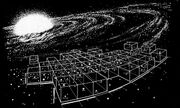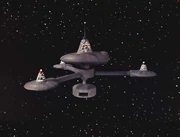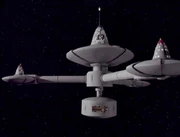AT: "xx"
Deep Space Station K-7 was a Federation deep space station that was in service in the mid-23rd century. This station was constructed by Starfleet and was administered by a civilian staff. Located within Federation space, K-7 was situated near the border of the Klingon Empire, was approximately 3.26 light years from the nearest Klingon outpost, and was at least two hundred light years from the Cardassian Union. In 2268, the station's manager was Mr. Lurry. The station was located in the Alpha Quadrant. (TOS: "The Trouble with Tribbles"; DS9: "Trials and Tribble-ations")
History
In the year 2268 Cyrano Jones, an interstellar trader, introduced a litter of tribbles to K-7, which quickly grew into an infestation. (TOS: "The Trouble with Tribbles")

IKS Gr'oth and USS Enterprise orbiting the station
The infestation coincided with the arrival of Federation undersecretary Nilz Baris, who transported several tons of the grain quadrotriticale to K-7, intended for cultivation on Sherman's Planet. Unbeknownst to Federation officials, the grain had been poisoned by Klingon spy Arne Darvin, in collusion with the visiting crew of the IKS Gr'oth. It was not until hundreds of tribbles were found dead, gorged on the poisoned grain, that the contamination was revealed. (TOS: "The Trouble with Tribbles"; TAS: "More Tribbles, More Troubles")
In the year 2373, an elderly Arne Darvin, traveled back to K-7 of the past, where he planted a tricobalt bomb, intended to kill Starfleet Captain James T. Kirk and prevent his own "dishonor". Darvin was ultimately caught by Captain Benjamin Sisko and the crew of the USS Defiant and returned to the 24th century. This incident caused some minor changes in the timeline to take place. In one instance, Miles O'Brien and Julian Bashir, disguised as members of Kirk's crew, became involved in a bar brawl between Klingons and Enterprise crewmembers. After the fight, Kirk lined up his officers for questioning. Prior to the temporal change, Freeman was questioned by Kirk, but the temporal incursion caused O'Brien to take his place.
Design

The shuttlebay of K-7.
The 30 decks of K-7 and the three outboard modules labeled K-A, K-B and K-C mainly consisted of storage areas and industrial fabrication facilities. Among the recreational areas available on the station was a bar frequented by intergalactic trader Cyrano Jones. The manager's office featured a two person transporter pad. The station had two docking bays for small starships and auxiliary spacecraft.
In 2268, the Class F shuttlecraft NCC-K7 and the Spacematic, Cyrano Jones' vessel, were stored in docking bay 2. (DS9: "Trials and Tribble-ations")
Station personnel
| Deep Space stations | |
|---|---|
| Deep Space 2 • Deep Space 3 • Deep Space 4 • Deep Space 5 • Deep Space 7 • Deep Space 9 • Deep Space 11 • Deep Space 12 • Deep Space 253 • Deep Space Repair Beta Six • Deep Space Station K-7 • Hubble Deep Space Station • Tau Ceti Deep Space Station | |
Appendices
Appearances
Background information
According to Star Trek Maps (Chart B), the K-7 was a Federation K-class deep space station. One of seventeen such stations scattered around the periphery of Federation space at the time, to serve as resupply stations and drydocks in areas where there were no inhabited star systems.
The registry of the NCC-K7 shuttlecraft assigned to the station suggests the possibility NCC-K7 was the registry number assigned to the station. Star Trek Star Fleet Technical Manual also depicts a shuttle assigned to Starbase 1 with a NCC-registry, NCC-6038⁄5. The shuttles not assigned to starships that appeared later on in the remastered episodes of Star Trek, such as the Picasso, were registered differently as "SB11-1201⁄1". It should be noted though that Starbase 11 the Picasso was assigned to was not a space station.
The exact dimensions of the station were not established, but it appeared to be roughly the same size as, or slightly bigger than, a Template:ShipClass starship.

The location of the Federation-Klingon border in "The Explored Galaxy" star chart
According to the Federation star chart "The Explored Galaxy", the Federation-Klingon border (between Organia and Kling) was located between the Tholian Assembly and Romulus. Both were identified in dialog in DS9: "Call to Arms" as being located in the Alpha Quadrant. According to the Star Trek: Star Charts (page 56), Deep Space K-7 was located in the Beta Quadrant.
Studio model
The K-7 was based on a model for a real-life space station/moon base proposed by Douglas Aircraft as early as 1960. Intended to be housed in the top stage of the Saturn 1B or Saturn V rocket, it was designed to deploy like an inflatable balloon. Concept models and concept art of the Douglas inflatable space station are featured on the PROJECT RHO Reference website and on Datin's website.
Original studio model

Original K-7, from 1967
In 1967 Gene Roddenberry acquired the Douglas Aircraft model. The Howard Anderson Company called Richard C. Datin, Jr. in to do modifications on the model for it to become K-7. As Datin remembered, "(...)I don't believe the revisions were based on any drawings, just following instructions given to me, I think by Jefferies. In other words, I had a more or less free hand in revising the model as long as it would stand up to the rigors of filming, be credible, and make any last alterations/additions to suit their needs. I haven't the remotest idea that any drawings existed...possibly a couple of hand-drawn sketches furnished by Matt may have been it."
On constructing the model:
"I vaguely recall it was either an off-white, dull of course, or very similar to the light gray/green Enterprise color. The model was composed of a material very unfamiliar to me. In perspective, more distinct than other substances from those days, it was a strange material. It was soft, yet resilient, but a rubbery substance, more foam-like but dense enough to hold its shape an be worked satisfactorily by machines. Each of the components, or satellite sections, were cast in this material and the alterations consisted of replacing the existing rods that held them together with Plexiglas tubing to allow electrical wiring to pass through to each other. Looking at the parts purchased for the alteration job, it looks as though I added some dome-like Plexiglas pieces to the satellites-most likely to alter their appearance sufficiently from the original Douglas design." (Star Trek: Communicator issue 133, pp. 49-50)
On operating the model (when mounted on a pipe from the bottom, serving as a center support and hiding the electrical wiring) on 1 and 5 September 1967:"(...)At Howard Anderson's, during filming, I sat under it and rotated it and turned lights on and off. Then I was matted out of the shot(...)"(Cinefantastique, Vol.27, No.11/12, p. 68) The markings on the model read "United Federation of Planets" on the main section, "K-A","K-B" and "K-C" on the cones of the three circular pods and "K-7" on the central cone.
Datin modified the model from 19 to 29 August 1967 at a total cost of $688 , including his fee for operating the model. (Star Trek: Communicator issue 133, p. 50) This proved to be his last involvement with Star Trek. Debuting in TOS: "The Trouble with Tribbles", this space station design was the only one ever used in original version of The Original Series. Stock footage of the K-7 space station was later seen in the original version of "The Ultimate Computer" to represent another space station, Starbase 6.
The studio model built for The Original Series has been missing for decades, either lost or destroyed.
Trials and Tribble-ations model

Revised K-7, from 1996
In 1996, a new model was built by Greg Jein for use in DS9's tribute episode, "Trials and Tribble-ations". Built not from original blueprints, but from detail gleaned from watching the original show and by studying the few existing production photos and blow-ups from stills from the original episode, Jein recreated the station down to details that were never visible in that episode, like a cone-shaped structure on the back, a strobe light on the bottom, rotating pods and the block letters that read K-7. Jein explained:
"Fortunately, the clarity of detail revealed by the newly transferred original footage of "The Trouble with Tribbles" proved useful. The art department sent over a drawing that they'd made of the station, Then we made some modifications based on color prints made from the original negative, which we felt were faithful to the original design. And we sort of winged it from there.[remark: after lathe turning wood for the towers and purchasing "standard architectural material" for the tubes] Then we made molds and cast them, cut the windows out, and put neon inside."(The Magic of Tribbles: The Making of Trials and Tribble-ations, p. 42)
After receiving the model, Visual Effects Supervisor Gary Hutzel recalled:"The model came over and it had these big block letters K-7 on top. It looked so goofy. It didn't look anything like the original. We powered it up, turned on the lights, and it looked exactly like the original. The big K-7 went away, because the windows hid it" (Cinefantastique, Vol.29, No.6/7, p.70). The model featured new elements, including the spacecraft in a detailed shuttlebay [1]. That item came from one of Jein's co-workers, Jason Kaufmann, who expressed a desire to "mess around". What he came up with was a detailed miniature shuttle-bay outfitted with a NCC-K7 shuttlecraft and the Cyrano Jones' Spacematic, completely built from scratch, essentially from bits and pieces lying around Jein's model shop.(The Magic of Tribbles: The Making of Trials and Tribble-ations, p. 43)
Unaware of Datin's stint at Howard Anderson Company back in 1967, Doug Drexler discovered the rotating motion and had Larry DeUnger of Boss Films repeat the action.(The Magic of Tribbles: The Making of Trials and Tribble-ations, pp. 44-45}
The last time this filming model was seen, was in storage at Image G, where it was filmed for the episode [2], but like its progenitor, its current whereabouts are unknown as the model has not been sighted since.
CGI model

CGI K-7, remastered
Yet another version of K-7, this time rendered digitally, was created for the 2006 "remastered" version of "The Trouble with Tribbles" as a CGI visual effect at CBS Digital, supervised by Dave Rossi and Niel Wray. Though the K-7 doubled as Starbase 6 in the original airing of "The Ultimate Computer", for the 2008 remastering of that episode, that station was retconned with an entirely new design. It became therefore impossible to determine if the K-7 type of stations was also used in the mid-23rd century as the more general starbases referred to in the dialogue of several episodes.
Apocrypha
- According to The Art of the Impossible by Keith R.A. DeCandido, the K-7 had fallen into disrepair by the 2340s and hadn't been upgraded or refitted in decades.
- The K-7 station itself appeared in the video game Star Trek: Elite Force II set in the late 24th century. The station was also run down and owned by a Klingon named Lurok. Yet another K-7 type station appeared in a skirmish map on the video game Star Trek: Legacy, where it was simply labeled as a trading station.
- In Star Trek Online, which takes place in 2409, K-7's internal systems appear to have been refitted. The station is placed in an orbit around Sherman's Planet and is under the command of Starfleet Commander Naomi Wildman. Lieutenant commander Icheb also serves aboard the station.
External link
- Template:NCwiki
